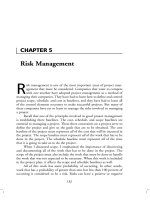Marketing chapter 5 good chains
Bạn đang xem bản rút gọn của tài liệu. Xem và tải ngay bản đầy đủ của tài liệu tại đây (1.48 MB, 45 trang )
Pricing Products: Pricing Strategies
11
Principles of Marketing
1
Monday, 31 October 11
Learning Objectives
After studying this chapter, you should be able to:
1. Describe the major strategies for pricing initiative and
new products
2. Explain how companies find a set of prices that
maximise the profits from the total product mix
3. Discuss how companies adjust their prices to take
into account different types of customers and
situations
4. Discuss the key issues related to initiating and
responding to price changes
2
Monday, 31 October 11
Chapter Outline
1. New-Product Pricing Strategies
2. Product Mix Pricing Strategies
3. Price Adjustment Strategies
4. Price Changes
5. Public Policy and Pricing
3
Monday, 31 October 11
1. New-Product Pricing Strategies
4
Monday, 31 October 11
New-Product Pricing Strategies
•
Market skimming pricing: Setting a high price
for a new product to skim maximum revenues
layer by layer from the segments willing to pay
the high price; the company makes fewer but
more profitable sales.
•
Market penetration pricing: Setting a low
price for a new product in order to attract a
large number of buyers and a large market
share
5
Monday, 31 October 11
New-Product Pricing Strategies
Market skimming pricing is a strategy with high initial prices to
“skim” revenue layers from the market
•
Product quality and image must
support the price
•
Buyers must want the product at
the price
•
Costs of producing the product
in small volume should not
cancel the advantage of higher
prices
•
Competitors should not be able
to enter the market easily
6
Monday, 31 October 11
New-Product Pricing Strategies
Market penetration pricing sets a low initial price in
order to penetrate the market quickly and deeply to
attract a large number of buyers quickly to gain market
share
•
Price sensitive market
•
Inverse relationship of
production and distribution
cost to sales growth
•
Low prices must keep
competition out of the
market
7
Monday, 31 October 11
2. Product Mix Pricing Strategies
8
Monday, 31 October 11
Product Mix Pricing Strategies
Strategy
Description
Product line pricing
Setting price steps between product line items
Optional-product pricing
Pricing optional or accessory product sold with the
main product
Captive-product pricing
Pricing products that must be used with the main
product
By-product pricing
Pricing low-value by-products to get rid of them
Product bundle pricing
Pricing bundles of products sold together
9
Monday, 31 October 11
Product Mix Pricing Strategies
Product line pricing takes into account the cost
differences between products in the line, customer
evaluation of their features, and competitors’
prices
10
Monday, 31 October 11
Product Mix Pricing Strategies
Optional product pricing takes into account
optional or accessory products along with the
main product
11
Monday, 31 October 11
Product Mix Pricing Strategies
Captive product pricing involves products that
must be used along with the main product
12
Monday, 31 October 11
Product Mix Pricing Strategies
13
Two-part pricing is where the price is broken into:
•
Fixed fee
•
Variable usage fee
Monday, 31 October 11
By-product pricing refers to products with little or
no value produced as a result of the main product.
Producers will seek little or no profit other than the
cost to cover storage and delivery.
14
Product Mix Pricing Strategies
Monday, 31 October 11
Product bundle pricing combines several
products at a reduced price
15
Product Mix Pricing Strategies
Monday, 31 October 11
3. Price-Adjustment Strategies
16
Monday, 31 October 11
Price Adjustment Strategies
17
Strategy
Description
Discount and allowance
pricing
Reducing prices to reward customer responses such as
paying early or promoting the product
Segmented pricing
Adjusting prices to allow for differences in customers,
products, or locations
Psychological pricing
Adjusting prices for psychological effect
Promotional pricing
Temporarily reducing prices to increase short-run sales
Geographical pricing
Adjusting prices to account for the geographic location
of customers
Dynamic pricing
Adjusting prices continually to meet the characteristics
and needs of individual customers and situations
International pricing
Adjusting prices for international markets
Monday, 31 October 11
Price Adjustment Strategies
Discount and allowance pricing reduces prices
to reward customer responses such as paying
early or promoting the product
•
Discounts
•
Allowances
18
Monday, 31 October 11
Price Adjustment Strategies
•
Discounts
•
Cash discount for paying promptly
•
Quantity discount for buying in large volume
•
Functional (trade) discount for selling, storing,
distribution, and record keeping
•
Allowances
•
Trade in allowance for turning in an old item when
buying a new one
•
Promotional allowance to reward dealers for
participating in advertising or sales support
programs
19
Monday, 31 October 11
Price Adjustment Strategies
Segmented pricing is used when a company sells
a product at two or more prices even though the
difference is not based on cost
•
Customer segment pricing
•
Product form segment pricing
•
Location pricing
20
Monday, 31 October 11
Price Adjustment Strategies
To be effective:
•
Market must be segmentable
•
Segments must show different degrees of demand
•
Watching the market cannot exceed the extra
revenue obtained from the price difference
•
Must be legal
21
Monday, 31 October 11
Customer segment pricing is when different customers
pay different prices for the same product or service
Product form segment pricing is when different
versions of the product are priced differently but not
according to differences in cost
Location pricing is when the product is sold in different
geographic areas and priced differently in those areas,
even thought the cost is the same
22
Price Adjustment Strategies
Monday, 31 October 11
Price Adjustment Strategies
Robert Cross
Revenue management charges the right
customer the right price at the right time
Yield management balances price and demand
23
Monday, 31 October 11
Price Adjustment Strategies
Psychological pricing occurs when sellers consider the
psychology of prices and not simply the economics
24
•
Reference prices are prices
that buyers carry in their
minds and refer to when
looking at a given product
•
Noting current prices
•
Remembering past prices
•
Assessing the buying situations
Monday, 31 October 11
Price Adjustment Strategies
Promotional pricing is when prices are temporarily
priced below list price or cost to increase demand
•
Loss leaders
•
Special event pricing
•
Cash rebates
•
Low interest financing
•
Longer warrantees
•
Free maintenance
25
Monday, 31 October 11









